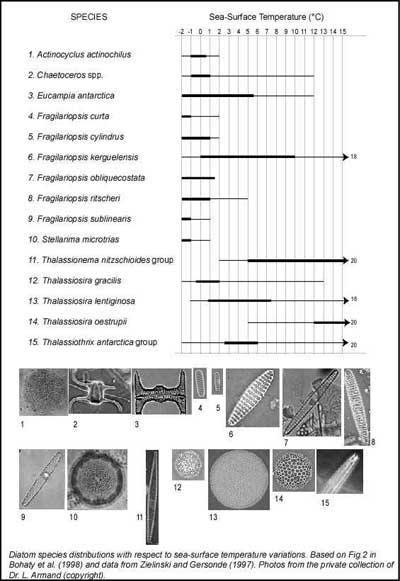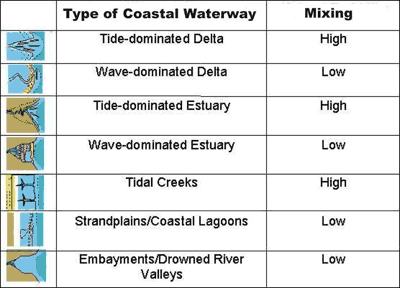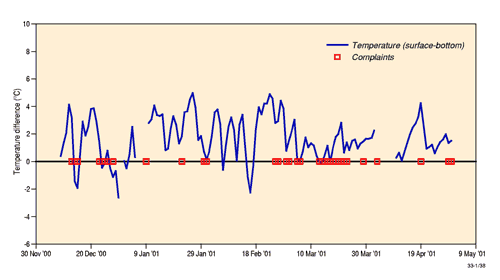What is water temperature?
Water temperature is a measure of the degree of hotness or coldness of water (or the kinetic energy). Unnatural changes in water temperature are a suggested indicator of water quality in the ANZECC & ARMCANZ guidelines1. Changes in sea surface temperature in marine and coastal waters are also a suggested indicator for State of the Environment reporting (e.g. Indicator 8.2 in the Estuaries and the Sea volume)2.
Significance of water temperature
Water temperature regulates ecosystem functioning both directly through physiological effects on organisms, and indirectly, as a consequence of habitat loss1. Photosynthesis and aerobic respiration, and the growth, reproduction, metabolism and the mobility of organisms are all affected by changes in water temperature. Indeed, the rates of biochemical reactions usually double when temperature is increased by 10oC within the given tolerance range of an organism1. This is called the Q10 rule, and it also applies to microbial processes such as nitrogen fixation, nitrification and denitrification. Aquatic organisms can only survive within a particular temperature range. If temperature goes too far above or below the tolerance range for a given species (e.g. fish, insects, benthic invertebrates, zooplankton, phytoplankton & microbes), its ability to survive may be compromised. For example, coral species live within a relatively narrow temperature range, and positive or negative temperature anomalies of only a few degrees can induce bleaching3. We provide an example of how species composition (e.g. diatoms) can change with water temperature in Figure 1.
Unnatural changes in water temperature impact indirectly upon biota through loss of supporting habitat such as coral reefs3, by changing the solubility of oxygen and calcium carbonate (calcite or aragonite) in water, or by influencing the extent to which metal contaminants45 and other toxicants are assimilated by physiological processes. Water temperature is also probably the most important factor influencing viral persistence in estuarine environments6.
Water temperature influences the density, conductivity and pH of a water column. In addition, solubility of gases (e.g. dissolved oxygen and carbon dioxide) decreases with increasing temperature (solubility being the maximum amount of gas that can be dissolved in a given volume of water). Water is more likely to become anoxic or hypoxic under warmer conditions because of increased bacterial respiration and a decreased ability of water to hold dissolve oxygen.
What causes water temperature to change?
The major seasonal cause of water temperature change is due to the change in solar insolation in addition to currents and local hydrodynamics. Also, temperature in surface waters varies during the day and tends to be highest in the late afternoon as the sun sets. Some more specific causes of water temperature variation in coastal waters may include:
- Changes in the amount of freshwater (riverine) flow, and the extent to which freshwater is mixed with marine water by winds or tides.
- Discharges of ‘cooling’ waters from power plants and municipal or industrial effluent are sources of thermal pollution in the coastal zone.
- Changes in air temperature and shifts in currents occurring in response to ENSO oscillations or global warming.

Figure 1. Diatom species distributions with respect to sea-surface temperature variations7.
Coastal waterways most susceptible to unnatural changes in temperature
Well-mixed waterways are buffered to some extent from thermal pollution. Tide-dominated coastal waterways (e.g. deltas, estuaries and tidal creeks) tend to be better mixed than wave-dominated coastal waterways (e.g. deltas, estuaries and strandplains/coastal lagoons) (Figure 2)8. River flow and waves can also facilitate mixing, especially in very shallow coastal waterways.

Figure 2. Mixing by tides is high in tide-dominated coastal systems and naturally low in wave-dominated coastal systems (from https://data.gov.au/dataset/australian-estuaries-and-coastal-waterways-a-geoscience-perspective-for-improved-and-integrated 8 ).
Considerations for measurement and interpretation
It is good practice to measure temperature when taking any physical, chemical or biological sample. Temperature measurements are usually made with digital instruments or mercury thermometers (with 0.1oC increments).
In water less than a few meters deep, daily fluctuation in temperature can be several degrees, and the interpretation of a temperature measurements needs to consider this variation.
Temperature loggers can also be deployed to measure and record temperatures at different depths and over specified periods of time. Long-term monitoring of water temperature provides an insight into seasonal and inter-annual temperature cycles, as well as into temperature anomalies caused by human activities. Sudden or large changes in temperature are generally of concern in coastal areas.
Large temperature differences between surface and bottom waters are indicative of stratification (see Figure 3). Stratification is most likely to occur in wave-dominated coastal waterways (e.g. deltas, estuaries and strandplains/coastal lagoons) because these waterways typically have low internal tide penetration (see salinity information sheet).

Figure 3. Temperature differences between surface and bottom waters in Lake Wollumboola, NSW (from Haines et al., 20019 ). Large temperature differences between surface and bottom waters are indicative of stratification and small temperature differences are indicative of de-stratification. Note that complaints (red squares) concerning rotten egg smells (hydrogen sulfide) coming from the lake often occur when the water column loses stratification, and temperature differences between surface and bottom waters approach zero.
Existing information and data
Since temperature is a routine and simple measurement, large amounts of data exist for estuaries and coastal waters from around Australia. The data is held by the collecting agencies (state, local government, community groups and environmental consultants). The BlueLink website provides forecasts of the ocean (water temperature and current) similar to the land-based weather forecasting and allows one to better monitor, predict, utilise and protect the vast marine environment surrounding Australia.
Contributors
Leanne Armand, University of Tasmania.
Lynda Radke, Geoscience Australia
Ian Webster, CSIRO Land & Water
- ANZECC/ARMCANZ (October 2000) Australian Guidelines for Water Quality Monitoring and Reporting. ↩ ↩ ↩
- Ward, T., Butler, E. and Hill, B. 1998. Environmental Indicators for State of Environment Reporting, Commonwealth of Australia, pp. 81. ↩
- Hoegh-Guldberg, O. 1999. Climate change, coral bleaching and the future of the world’s coral reefs. Marine and Freshwater Research 50, 839-866. ↩ ↩
- Luoma, S.N. 1983. Bioavailability of trace metals to aquatic organisms – A review. The science of the total environment 28, 1-22. ↩
- Elder, J.F. 1988. Metal Biogeochemistry in Surface-Water Systems – A Review of Principles and Concepts. U.S. Geological Survey Circular 1013. ↩
- Miller, B.M. Issues for the modelling of fate and transport of viruses in estuarine environments, 15th Australasian Coastal and Ocean Engineering Conference, September 2001, Gold Coast. ↩
- Zielinski, U. & Gersonde, R., 1997. Diatom distribution in Southern Ocean surface sediments (Atlantic sector): Implications for palaeoenvironmental reconstructions. Palaeogeography, Palaeoclimatology, Palaeoecology 129, 213-250. ↩
- Heap, A., Bryce, S., Ryan, D., Radke, L., Smith, C., Smith, R., Harris, P. and D. Heggie. 2001.https://data.gov.au/dataset/australian-estuaries-and-coastal-waterways-a-geoscience-perspective-for-improved-and-integrated. AGSO Record 2001/07, pp. 118. ↩ ↩
- Haines, Skyring, Stephens, Papworth (2001) Managing Lake Wollumboola’s Odour Problem. Proc. 11th NSW Coastal Conference, Newcastle 13-16 November 2001. ↩


